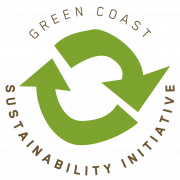Good Use for Old Rubbish
Instead of just dumping everything we collect from our customers, we look for inventive ways to divert as much as we can from landfills. We donate as many items as possible and target specific materials for reuse or repurposing in other applications.

In this spirit, we have branded our customized process as the Green Coast Sustainability Initiative. We believe we embody the term Initiative as defined as “the power or opportunity to act or take charge before others do” as we strive to make an environmental difference with each project we take on.
Donations
Every year, we donate several thousands of pounds of items to deserving non-profit organizations in our community. Donations include recyclables, furniture, clothing, household goods and a variety of other reusable materials.
By diverting usable materials from landfills and donating them, Green Coast supports the following community organizations:
- Habitat for Humanity
- The Salvation Army
- The Canadian Diabetes Association
- Helping Families in Need Society
- Urban Repurpose
- Downtown East Side Women’s Centre
- Harvest Project
- Shelter to Home
Diversion from Landfills
We are committed to diverting as much waste as possible from landfills, and we make every effort to recycle, reuse and repurpose as much material as we can. Our diversion rate is consistently over 75 percent, based on data collected by Climate Smart (2010 – 2020).
In a typical year, we divert more than a million pounds of material through our green junk removal practices as reported by Climate Smart. That’s material that doesn’t end up in our landfills.
Comparative Diversion Examples
For a visual of how much waste Green Coast diverts from landfills every year, here are some examples of items with an equivalent weight:
Types of Material Diverted From Landfills
Building Materials
Drywall, concrete, tile, brick, dirt, asphalt, and roofing shingles
Compost
Green waste, compost, branches, leaves, grass, and organic debris
Biomass
Wood, plywood, and wood by-products
Other Materials
Furniture, mattresses, carpet, couches, appliances, electronics (including TV’s, computers, stereos, and cellphones), batteries (car, marine & household), paint, Styrofoam, gasoline, pesticides, oil, aerosol cans, tires, plastic, cardboard, paper, newsprint, glass, organic wastewater, fluorescent tubes etc.

Chart data: Climate Smart, 2010 – 2020
Reducing our Carbon Footprint
We are committed to sustainable junk removal practices that reduce our greenhouse gas footprint.
Using 2010 as our baseline through Climate Smart, we measured our carbon emissions and planned our emission reductions accordingly. Our annual greenhouse gas (GHG) emissions inventory allows us to track reductions in our use of electricity, heating, transportation, and paper.
Every year, we reduce our carbon footprint by making greenhouse gas emission reductions in the following areas:
- Transporting People
- Staff Commuting
- Heat
- Electricity
- Garbage
- Paper
Emission Reduction Initiatives
To further reduce our environmental impact, Green Coast has taken the following emission reduction initiatives:
- Offering transit passes to employees
- Invoicing electronically, direct deposit paycheques, use of tablets and other paperless digital technologies
- Powering down ‘phantom load’ devices at night to reduce electricity usage
- Optimizing route efficiency for our junk removal fleet to reduce fuel consumption and carbon emissions
- Reducing reliance on gasoline and increasing use of biodiesel for vehicle fleet
- Continuing to reduce the amount of waste sent to landfills with ongoing innovation in waste diversion and recycling practices
- Leveraging necessary technology within our office to be energy-efficient, including LED ‘Smart’ lighting and various appliances
Looking Forward
As we look to the future, we strive to continue fostering existing relationships through meaningful projects within our local communities, forge new partnerships and find innovative solutions to repurpose or reuse disposable material.
















